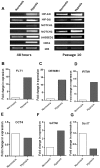Increased proliferation and analysis of differential gene expression in human Wharton's jelly-derived mesenchymal stromal cells under hypoxia
- PMID: 20877435
- PMCID: PMC2945278
- DOI: 10.7150/ijbs.6.499
Increased proliferation and analysis of differential gene expression in human Wharton's jelly-derived mesenchymal stromal cells under hypoxia
Abstract
Multipotent mesenchymal stromal cells (MSCs) from Wharton's jelly (WJ) of umbilical cord bear higher proliferation rate and self-renewal capacity than adult tissue-derived MSCs and are a primitive stromal cell population. Stem cell niche or physiological microenvironment plays a crucial role in maintenance of stem cell properties and oxygen concentration is an important component of the stem cell niche. Low oxygen tension or hypoxia is prevalent in the microenvironment of embryonic stem cells and many adult stem cells at early stages of development. Again, in vivo, MSCs are known to home specifically to hypoxic events following tissue injuries. Here we examined the effect of hypoxia on proliferation and in vitro differentiation potential of WJ-MSCs. Under hypoxia, WJ-MSCs exhibited improved proliferative potential while maintaining multi-lineage differentiation potential and surface marker expression. Hypoxic WJ-MSCs expressed higher mRNA levels of hypoxia inducible factors, notch receptors and notch downstream gene HES1. Gene expression profile of WJ-MSCs exposed to hypoxia and normoxia was compared and we identified a differential gene expression pattern where several stem cells markers and early mesodermal/endothelial genes such as DESMIN, CD34, ACTC were upregulated under hypoxia, suggesting that in vitro culturing of WJ-MSCs under hypoxic conditions leads to adoption of a mesodermal/endothelial fate. Thus, we demonstrate for the first time the effect of hypoxia on gene expression and growth kinetics of WJ-MSCs. Finally, although WJ-MSCs do not induce teratomas, under stressful and long-term culture conditions, MSCs can occasionally undergo transformation. Though there were no chromosomal abnormalities, certain transformation markers were upregulated in a few of the samples of WJ-MSCs under hypoxia.
Keywords: Cell proliferation.; Hypoxia; Mesenchymal stem cells (MSCs); Transcription; Transformation markers; Wharton's jelly.
Conflict of interest statement
Conflict of Interests: The authors declare no competing financial interests.
Figures





Similar articles
-
Improving stemness and functional features of mesenchymal stem cells from Wharton's jelly of a human umbilical cord by mimicking the native, low oxygen stem cell niche.Placenta. 2019 Jul;82:25-34. doi: 10.1016/j.placenta.2019.05.005. Epub 2019 May 13. Placenta. 2019. PMID: 31174623
-
Hypoxia with Wharton's jelly mesenchymal stem cell coculture maintains stemness of umbilical cord blood-derived CD34+ cells.Stem Cell Res Ther. 2018 Jun 13;9(1):158. doi: 10.1186/s13287-018-0902-5. Stem Cell Res Ther. 2018. PMID: 29895317 Free PMC article.
-
Differential expression of cell cycle and WNT pathway-related genes accounts for differences in the growth and differentiation potential of Wharton's jelly and bone marrow-derived mesenchymal stem cells.Stem Cell Res Ther. 2017 Apr 26;8(1):102. doi: 10.1186/s13287-017-0555-9. Stem Cell Res Ther. 2017. PMID: 28446235 Free PMC article.
-
Characteristics and clinical applications of Wharton's jelly-derived mesenchymal stromal cells.Curr Res Transl Med. 2020 Jan;68(1):5-16. doi: 10.1016/j.retram.2019.09.001. Epub 2019 Sep 19. Curr Res Transl Med. 2020. PMID: 31543433 Review.
-
Regenerative potential of Wharton's jelly-derived mesenchymal stem cells: A new horizon of stem cell therapy.J Cell Physiol. 2020 Dec;235(12):9230-9240. doi: 10.1002/jcp.29810. Epub 2020 Jun 18. J Cell Physiol. 2020. PMID: 32557631 Review.
Cited by
-
LncRNA SNHG11 promotes the malignant transformation of human bronchial epithelial cells induced by beryllium sulfate.Toxicol Res (Camb). 2022 Jun 21;11(4):605-615. doi: 10.1093/toxres/tfac036. eCollection 2022 Aug. Toxicol Res (Camb). 2022. PMID: 36051663 Free PMC article.
-
Factors governing the immunosuppressive effects of multipotent mesenchymal stromal cells in vitro.Cytotechnology. 2016 Aug;68(4):565-77. doi: 10.1007/s10616-015-9906-5. Epub 2015 Aug 13. Cytotechnology. 2016. PMID: 26266638 Free PMC article. Review.
-
Hypoxia Inhibits Osteogenesis and Promotes Adipogenesis of Fibroblast-like Synoviocytes via Upregulation of Leptin in Patients with Rheumatoid Arthritis.J Immunol Res. 2022 Dec 7;2022:1431399. doi: 10.1155/2022/1431399. eCollection 2022. J Immunol Res. 2022. PMID: 36530571 Free PMC article.
-
Concise review: current trends on applications of stem cells in diabetic nephropathy.Cell Death Dis. 2020 Nov 21;11(11):1000. doi: 10.1038/s41419-020-03206-1. Cell Death Dis. 2020. PMID: 33221823 Free PMC article. Review.
-
Male germ-like cell differentiation potential of human umbilical cord Wharton's jelly-derived mesenchymal stem cells in co-culture with human placenta cells in presence of BMP4 and retinoic acid.Iran J Basic Med Sci. 2015 Apr;18(4):325-33. Iran J Basic Med Sci. 2015. PMID: 26019794 Free PMC article.
References
Publication types
MeSH terms
Substances
LinkOut - more resources
Full Text Sources
Other Literature Sources

